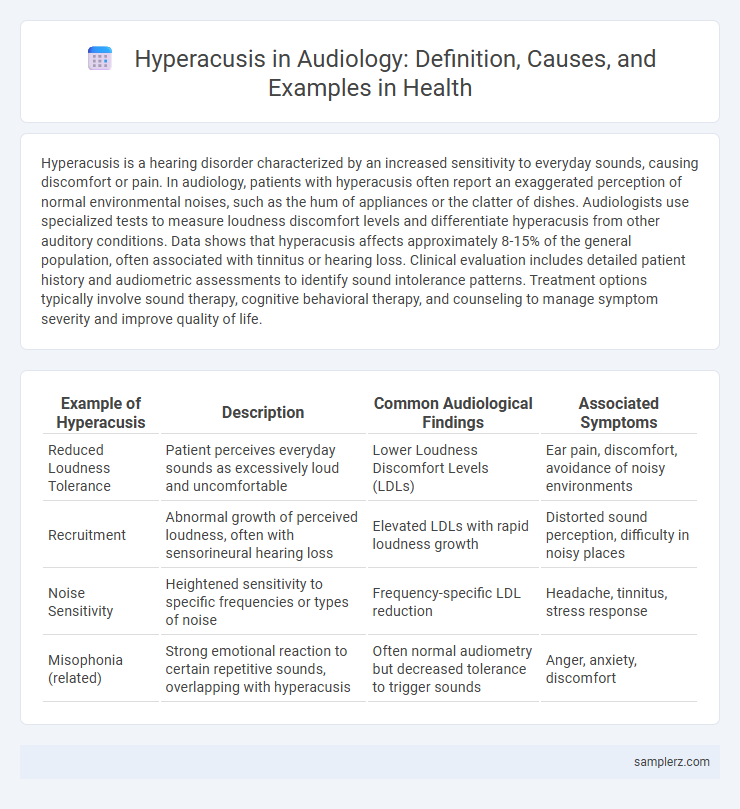Hyperacusis is a hearing disorder characterized by an increased sensitivity to everyday sounds, causing discomfort or pain. In audiology, patients with hyperacusis often report an exaggerated perception of normal environmental noises, such as the hum of appliances or the clatter of dishes. Audiologists use specialized tests to measure loudness discomfort levels and differentiate hyperacusis from other auditory conditions. Data shows that hyperacusis affects approximately 8-15% of the general population, often associated with tinnitus or hearing loss. Clinical evaluation includes detailed patient history and audiometric assessments to identify sound intolerance patterns. Treatment options typically involve sound therapy, cognitive behavioral therapy, and counseling to manage symptom severity and improve quality of life.
Table of Comparison
| Example of Hyperacusis | Description | Common Audiological Findings | Associated Symptoms |
|---|---|---|---|
| Reduced Loudness Tolerance | Patient perceives everyday sounds as excessively loud and uncomfortable | Lower Loudness Discomfort Levels (LDLs) | Ear pain, discomfort, avoidance of noisy environments |
| Recruitment | Abnormal growth of perceived loudness, often with sensorineural hearing loss | Elevated LDLs with rapid loudness growth | Distorted sound perception, difficulty in noisy places |
| Noise Sensitivity | Heightened sensitivity to specific frequencies or types of noise | Frequency-specific LDL reduction | Headache, tinnitus, stress response |
| Misophonia (related) | Strong emotional reaction to certain repetitive sounds, overlapping with hyperacusis | Often normal audiometry but decreased tolerance to trigger sounds | Anger, anxiety, discomfort |
Understanding Hyperacusis: Key Audiological Perspectives
Hyperacusis is characterized by an increased sensitivity to everyday sounds, causing discomfort or pain, often measured through loudness discomfort levels (LDL) in audiological evaluations. Patients with hyperacusis typically report intolerance to sounds that are normally perceived as safe, highlighting the importance of comprehensive audiometric testing and auditory brainstem response (ABR) assessments to identify underlying neural mechanisms. Effective management involves sound therapy and counseling, emphasizing tailored audiological rehabilitation to improve auditory tolerance and daily functioning.
Real-Life Case Studies of Hyperacusis Patients
Real-life case studies in audiology reveal hyperacusis patients experiencing extreme sensitivity to everyday sounds, such as normal conversation or background noise, which can significantly impair daily functioning. Patient records often highlight associated symptoms like tinnitus, anxiety, and auditory fatigue, emphasizing the need for personalized auditory rehabilitation strategies. These case studies provide critical insights into diagnostic challenges and the effectiveness of sound therapy and cognitive behavioral approaches in managing hyperacusis.
Common Triggers and Sounds Causing Hyperacusis
Common triggers of hyperacusis in audiology include everyday sounds such as vacuum cleaners, alarms, and loud conversations, which can cause disproportionate discomfort or pain. Sounds with high-pitched frequencies or sudden loud noises often exacerbate sensitivity, leading to auditory overload and stress. Patients frequently report heightened reactions to environmental noises like traffic, sirens, and electronic devices, highlighting the need for tailored sound therapy and noise management strategies.
Diagnostic Approaches in Identifying Hyperacusis
Audiologists utilize loudness discomfort levels (LDLs) and otoacoustic emissions (OAEs) to assess hyperacusis, a condition characterized by increased sensitivity to everyday sounds. The administration of pure tone audiometry, combined with patient self-report questionnaires like the Hyperacusis Questionnaire (HQ), enhances diagnostic accuracy. Objective measures such as acoustic reflex threshold testing further aid in distinguishing hyperacusis from related auditory disorders.
Hyperacusis in Children: Audiology Insights
Hyperacusis in children manifests as an increased sensitivity to everyday sounds, often causing discomfort or pain at volumes tolerated by peers. Audiologists assess this condition using tests like Loudness Discomfort Levels (LDL) and acoustic reflex measurements to evaluate the child's sound tolerance and auditory processing. Early diagnosis and tailored sound desensitization therapy improve auditory hypersensitivity outcomes, enhancing social and educational experiences for affected children.
Hyperacusis vs. Misophonia: Differential Audiological Examples
Hyperacusis manifests as an increased sensitivity to everyday environmental sounds, often causing discomfort or pain at moderate volumes, whereas misophonia specifically triggers strong emotional reactions to particular repetitive sounds like chewing or tapping. Audiological evaluations for hyperacusis typically include loudness discomfort level (LDL) testing, revealing lowered thresholds for sound tolerance, while misophonia diagnosis relies more on patient-reported emotional responses rather than standard audiometric measures. Differentiating these conditions is critical for clinicians to tailor effective management strategies, such as sound therapy for hyperacusis and cognitive-behavioral approaches for misophonia.
Impact of Hyperacusis on Daily Living
Hyperacusis, characterized by an increased sensitivity to normal environmental sounds, significantly disrupts daily activities such as conversations, work, and social interactions. Individuals with hyperacusis often experience discomfort or pain from common noises like traffic, household appliances, or conversations, leading to social withdrawal and increased stress levels. This auditory hypersensitivity can impair concentration, reduce sleep quality, and diminish overall quality of life, necessitating specialized audiological management and sound therapy.
Treatment Modalities for Hyperacusis in Audiology
Treatment modalities for hyperacusis in audiology primarily include sound therapy, which aims to desensitize the auditory system by gradually increasing tolerance to everyday sounds. Cognitive-behavioral therapy (CBT) is often incorporated to address the emotional and psychological impact of sound sensitivity, helping patients manage anxiety and distress. Use of custom ear protection and counseling on sound management strategies complement these approaches, optimizing overall treatment outcomes.
Hyperacusis and Tinnitus: Audiological Correlations
Hyperacusis often co-occurs with tinnitus, presenting a complex audiological profile characterized by increased sensitivity to sound and persistent ringing in the ears. Audiological evaluations reveal abnormal loudness perception and reduced sound tolerance, frequently linked to cochlear nerve dysfunction or central auditory processing abnormalities. Understanding the correlation between hyperacusis and tinnitus is critical for developing targeted therapies that address both sound sensitivity and tinnitus-related distress.
Preventive Strategies and Management in Hyperacusis
Hyperacusis in audiology manifests as an increased sensitivity to everyday sounds, often linked to conditions such as tinnitus or noise-induced hearing loss. Preventive strategies include minimizing exposure to loud noises, using protective earmuffs in high-decibel environments, and maintaining regular audiological assessments. Management typically involves sound therapy, cognitive behavioral therapy, and in some cases, custom hearing protection devices to gradually desensitize auditory pathways and improve patient quality of life.

example of hyperacusis in audiology Infographic
 samplerz.com
samplerz.com